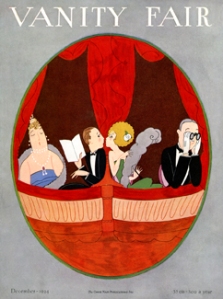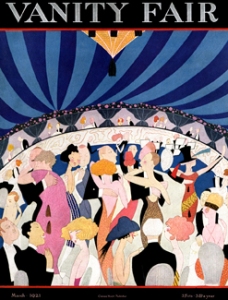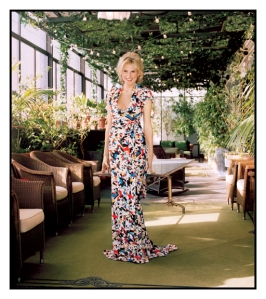Artist Spotlight: A.H. Fish
Note: Click on each image to get an enlarged view, read more information, and begin navigating through the entire image gallery.
On the wall of my dining room hangs a framed print of the December 1927 Vanity Fair cover. Lines radiating like rays of the sun outline Jazz Age flappers and the dandies who loved them, pressed cheek to cheek and engrossed in the tango. The illustration is lively, bright, and colorful and perfectly captures the spirit of the 1920s. The artist, known simply as Fish, first began appearing in the pages of Vanity Fair and The Tatler in 1914. Who was this Fish person, and why the funny name?
It turns out that Fish was Miss Fish, specifically Anne Harriet Fish, later Sefton, born in Bristol, England in 1890. In her nearly 15-year career at Condé Nast, she was credited with more than 30 covers and hundreds of inside and spot illustrations. At her best when depicting members of high society (no wonder Vanity Fair came calling), Fish used her natural artistic talent to document beau monde types with a pointed innocence that her contemporaries avoided.
In 1920, G. P. Putnam and Sons published a book entitled High Society: Advice as to Social Campaigning, and Hints on the Management of Dowagers, Dinners, Debutantes, Dances, and the Thousand and One Diversions of Persons of Quality. (Did they know how to come up with a title back then or what?!) The book is an anthology of society features from Vanity Fair and pairs drawings by Fish with text culled from articles by Dorothy Parker, George S. Chappell, and Frank Crowninshield. In an opening essay about the artist, signed “THE EDITOR,” the world of characters created by Fish is described thus:
It is a world populated by young-old matrons, astoundingly mature young girls, Victorian lady remnants, resplendent captains of industry, pussy-footing English butlers, amorous nursemaids, race touts, yearning young lovers, swanking soldiers, blank and vapid bores, bridge-playing parsons, and middle-class millionaires.
The essay, and the book, is very rare and difficult to find in print. Fortunately, it is available online through Google Books. You can even download a printable PDF of the entire book. It’s a really fun read – just be sure the printer is well stocked with paper and your boss isn’t looking.
It seems Fish’s work has now come full circle. While reading the April 2010 issue of Vanity Fair, this photograph of socialite Hayley Bloomingdale caught my eye. Actually, it was more the Carolina Herrera dress she is wearing that captured my attention – the dancers framed on my dining room wall are tangoing all over it. As vintage has come back to popular culture and fashion in full force, Fish may have captured the spirit of the 2010s as well.








Hi, I found 4 posters at an antique store, all were printed in London between 1969 and 1970. They are posters of covers from the 1920’s. The size of the posters is about 18 x 26. A friend of mine asked for them and I’m curious if they have any value.
Thanks,
Cindy
Hi, Cindy – We think these may be from a book of posters printed around this time, but doubt they are worth anything.
Thanks for the info, a few are the same as on your website. Were they originally designed for covers of magazines?
Yes, all of the Fish works in this post were originally Vanity Fair covers, though Fish also did some great inside illustrations. If you click on each image to enlarge it, you’ll see in the description for most of them that there is an “Available at the Conde Nast Store” link to purchase the images as prints.